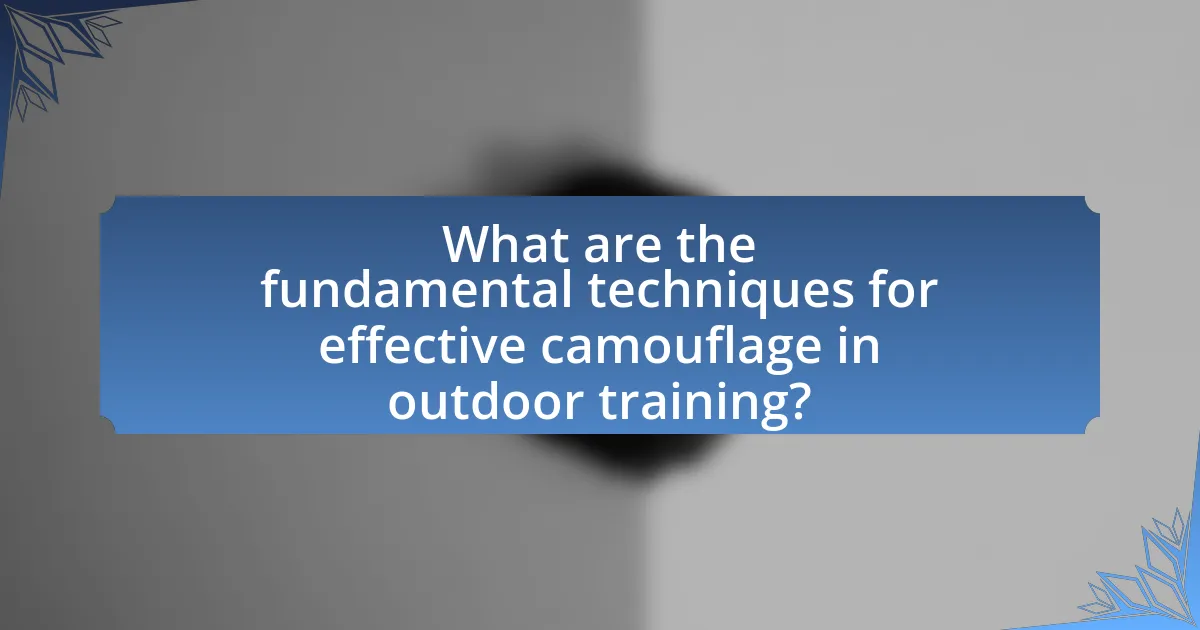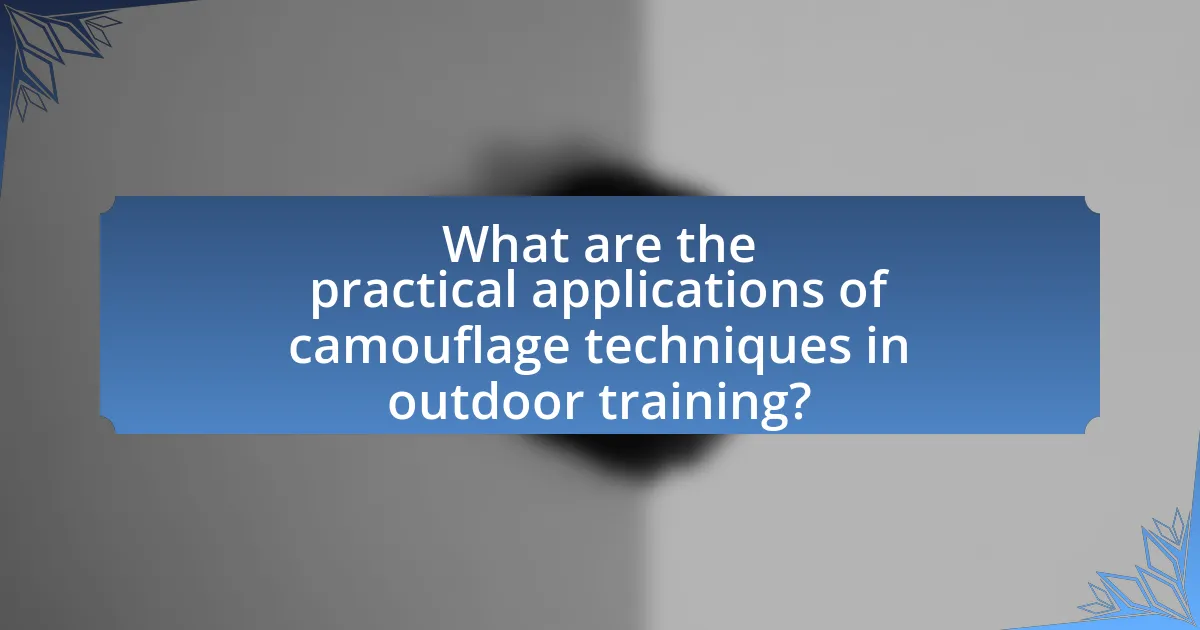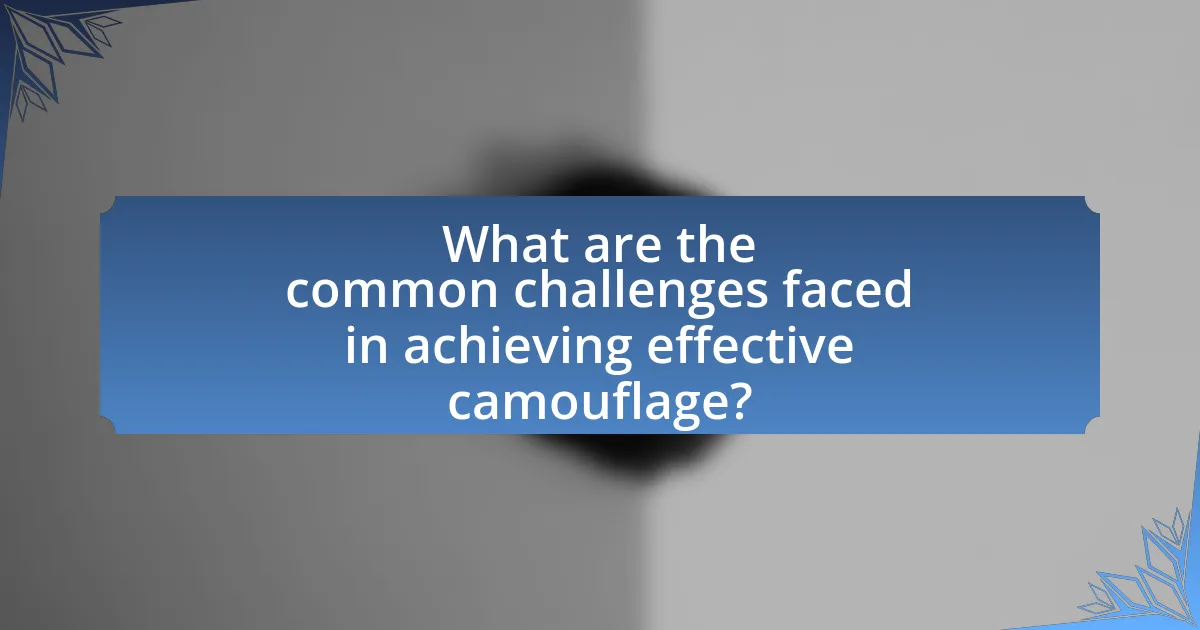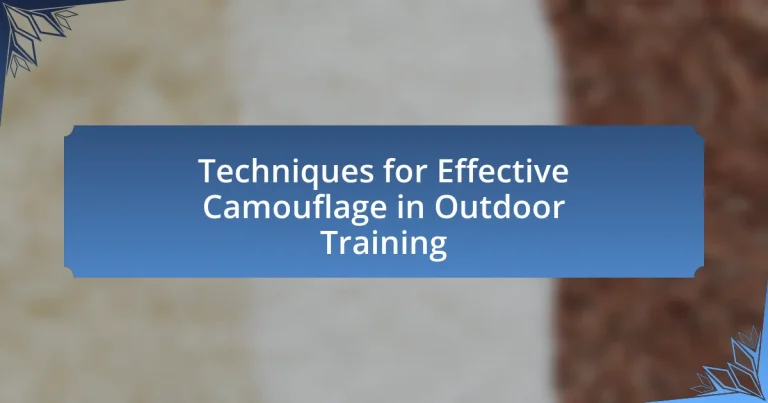The article focuses on techniques for effective camouflage in outdoor training, emphasizing the importance of blending with the environment, utilizing natural materials, and controlling movement to enhance concealment. Key factors such as color, texture, light, and seasonal changes are discussed, highlighting their impact on camouflage effectiveness. The article also explores practical applications in military exercises, wildlife observation, and search and rescue operations, while addressing common challenges and mistakes in achieving effective camouflage. Additionally, it provides insights into training methods, peer feedback, and best practices for maintaining camouflage in dynamic environments.

What are the fundamental techniques for effective camouflage in outdoor training?
The fundamental techniques for effective camouflage in outdoor training include blending with the environment, using natural materials, and employing movement control. Blending with the environment involves wearing colors and patterns that match the surroundings, which can significantly reduce visibility. Using natural materials, such as leaves, branches, and mud, helps to break up the outline of the body and create a more natural appearance. Movement control is crucial; remaining still and minimizing noise prevents detection by both human observers and wildlife. These techniques are supported by military training practices, which emphasize the importance of environmental awareness and adaptation for successful camouflage.
How does understanding the environment enhance camouflage effectiveness?
Understanding the environment significantly enhances camouflage effectiveness by allowing individuals to select appropriate colors, patterns, and materials that blend seamlessly with their surroundings. For instance, a soldier operating in a forested area benefits from using green and brown tones that mimic the foliage, while someone in a desert setting would choose sandy colors to match the terrain. Research indicates that effective camouflage can reduce detection rates by up to 90% when the colors and patterns are well-suited to the environment, as demonstrated in studies on military camouflage strategies. This knowledge enables individuals to adapt their appearance to specific habitats, thereby increasing their chances of remaining undetected.
What environmental factors should be considered for effective camouflage?
Effective camouflage requires consideration of environmental factors such as color, texture, light, and movement. Color matching the surroundings helps blend in with the environment, while texture can disrupt outlines and shapes. Light conditions, including shadows and highlights, influence visibility, making it essential to adapt camouflage patterns accordingly. Additionally, understanding the movement patterns of both the observer and the camouflaged subject is crucial, as sudden movements can reveal positions regardless of camouflage effectiveness. These factors are supported by studies in military tactics, which emphasize the importance of adapting camouflage to specific environments for optimal concealment.
How do seasonal changes impact camouflage strategies?
Seasonal changes significantly impact camouflage strategies by altering the colors and patterns of the environment, which necessitates adaptations in the appearance of organisms or military personnel. For instance, during winter, many animals develop white fur or feathers to blend in with snow, while in summer, they may shift to browns and greens to match the foliage. Research indicates that animals like the Arctic hare and the ptarmigan exhibit seasonal molting, changing their coloration to enhance concealment against predators. Similarly, military camouflage patterns are designed to adapt to seasonal environments, utilizing different color palettes and textures to optimize concealment in varying terrains.
What role does color play in camouflage techniques?
Color plays a crucial role in camouflage techniques by enabling organisms or objects to blend into their surroundings, thereby reducing visibility to predators or observers. This blending occurs through the use of colors that match or mimic the hues found in the environment, such as greens and browns in forested areas or grays and tans in desert settings. Research indicates that animals like chameleons and cuttlefish utilize color-changing abilities to adapt to their surroundings, enhancing their survival rates. Additionally, military camouflage patterns often incorporate a range of colors to disrupt outlines and create visual confusion, which has been shown to improve concealment effectiveness in various terrains.
How can color matching improve concealment in various terrains?
Color matching enhances concealment in various terrains by ensuring that an individual’s appearance blends seamlessly with the surrounding environment. This blending reduces the likelihood of detection by observers, as the human eye is less able to distinguish shapes and movements that are consistent with the colors and patterns of the terrain. For instance, research indicates that military camouflage patterns are specifically designed to mimic the colors and textures found in natural settings, such as forests or deserts, which significantly decreases visibility. Studies have shown that effective color matching can improve concealment effectiveness by up to 80% in specific environments, demonstrating its critical role in outdoor training scenarios.
What are the psychological effects of color on visibility?
The psychological effects of color on visibility significantly influence human perception and attention. Colors such as red and yellow are often associated with alertness and danger, making them highly visible and attention-grabbing in various environments. Research indicates that bright colors can enhance visibility by up to 80% in certain contexts, as demonstrated in studies on safety gear and signage. Conversely, colors like green and brown, which blend into natural environments, can reduce visibility and make objects less noticeable, impacting camouflage effectiveness. This understanding is crucial in outdoor training, where the choice of color can determine the success of camouflage techniques.
How do patterns and textures contribute to effective camouflage?
Patterns and textures significantly enhance effective camouflage by disrupting the outline of an object and blending it into the surrounding environment. Specific patterns, such as those mimicking natural elements like foliage or terrain, break up the visual continuity that predators or observers rely on to detect objects. Textures add depth and complexity, further aiding in the blending process by creating shadows and highlights that mimic the natural play of light in the environment. Research indicates that animals like the cuttlefish utilize similar strategies, demonstrating that effective camouflage relies on both visual disruption and environmental integration.
What types of patterns are most effective in different environments?
In outdoor training, the most effective camouflage patterns vary by environment, with specific designs optimized for different terrains. For example, woodland patterns, characterized by greens and browns, are highly effective in forested areas, blending seamlessly with foliage. In contrast, desert patterns, featuring tans and light browns, are designed to mimic the arid landscape, making them suitable for sandy environments. Urban patterns, which often include greys and blacks, are tailored for cityscapes, allowing individuals to blend into concrete surroundings. Research indicates that these specialized patterns enhance concealment by disrupting the outline of the wearer, making them less detectable to the human eye.
How does texture influence the perception of depth and distance?
Texture significantly influences the perception of depth and distance by providing visual cues that help the brain interpret spatial relationships. When surfaces exhibit varying textures, such as roughness or smoothness, these differences create contrast that the visual system uses to gauge how far away objects are. For instance, objects with finer textures appear to be farther away, while those with coarser textures seem closer, a phenomenon supported by the theory of texture gradient in visual perception. This theory posits that as texture elements become smaller and denser, they signal increased distance, aiding in depth perception.

What are the practical applications of camouflage techniques in outdoor training?
Camouflage techniques in outdoor training are practically applied to enhance concealment, improve stealth, and increase survival rates in various environments. These techniques enable individuals to blend into their surroundings, making them less detectable to both predators and adversaries. For instance, military personnel utilize camouflage patterns that mimic natural landscapes, which has been shown to reduce visibility by up to 90% in specific terrains. Additionally, outdoor training programs for wildlife observation and hunting emphasize the importance of camouflage to avoid alarming animals, thereby increasing the chances of successful encounters. The effectiveness of these techniques is supported by studies demonstrating that proper use of camouflage can significantly improve operational success in tactical scenarios.
How can camouflage techniques be integrated into training exercises?
Camouflage techniques can be integrated into training exercises by incorporating realistic scenarios that require participants to utilize concealment strategies effectively. Training exercises can simulate various environments, such as forests or urban settings, where trainees practice blending into their surroundings using natural materials and patterns. Research indicates that hands-on practice in diverse terrains enhances soldiers’ ability to apply camouflage in real-world situations, as demonstrated in military training programs that emphasize adaptive camouflage skills. Additionally, incorporating assessments that evaluate the effectiveness of camouflage application during exercises can reinforce learning and improve proficiency.
What specific training scenarios benefit from camouflage techniques?
Specific training scenarios that benefit from camouflage techniques include military exercises, wildlife observation, and search and rescue operations. In military exercises, camouflage enhances concealment, allowing troops to avoid detection by adversaries, which is crucial for tactical advantage. Wildlife observation relies on camouflage to minimize human presence, enabling researchers to study animal behavior without interference. In search and rescue operations, effective camouflage can help rescuers blend into environments, increasing the likelihood of locating individuals in distress without alarming them. These scenarios demonstrate the practical applications of camouflage techniques in enhancing effectiveness and safety in various outdoor training contexts.
How can instructors assess the effectiveness of camouflage in trainees?
Instructors can assess the effectiveness of camouflage in trainees by conducting field evaluations where trainees are observed in various environments. During these evaluations, instructors can measure how well trainees blend into their surroundings by using visual assessments and employing tools such as infrared cameras or thermal imaging to detect visibility. Studies have shown that effective camouflage can reduce detection rates significantly; for instance, research indicates that properly applied camouflage can decrease visibility by up to 90% in certain conditions. This quantifiable data supports the assessment process, allowing instructors to provide targeted feedback and improve trainees’ skills in real-world scenarios.
What tools and materials are essential for effective camouflage?
Essential tools and materials for effective camouflage include natural foliage, camouflage netting, and specialized clothing. Natural foliage, such as leaves and branches, helps blend into the environment, while camouflage netting provides additional concealment by mimicking the surrounding landscape. Specialized clothing, designed with patterns that break up the outline of the body, enhances the effectiveness of camouflage. Studies have shown that using these materials significantly increases concealment effectiveness in various terrains, making them crucial for outdoor training.
What types of gear enhance camouflage capabilities?
Types of gear that enhance camouflage capabilities include specialized clothing, face paint, and equipment designed to blend into the environment. Camouflage clothing often features patterns that mimic natural surroundings, such as woodland, desert, or urban designs, which help individuals remain undetected. Face paint is used to break up the outline of the face and reduce shine, further aiding in concealment. Additionally, gear like ghillie suits incorporates natural vegetation to provide effective cover in various terrains. These items are proven to improve stealth and reduce visibility, as demonstrated by military training programs that emphasize the importance of blending into the environment for operational success.
How can natural materials be utilized for camouflage purposes?
Natural materials can be utilized for camouflage purposes by mimicking the colors, textures, and patterns found in the environment. For instance, leaves, branches, and soil can be used to create a natural disguise that blends seamlessly with the surroundings, effectively reducing visibility to observers. Research indicates that using local vegetation not only enhances concealment but also aligns with the principles of adaptive camouflage, which relies on the natural variability of the environment to obscure the presence of individuals. This method has been employed in military training and wildlife observation, demonstrating its effectiveness in real-world applications.

What are the common challenges faced in achieving effective camouflage?
Achieving effective camouflage faces several common challenges, including environmental variability, material limitations, and human factors. Environmental variability, such as changing light conditions and diverse terrains, can affect how well camouflage patterns blend into surroundings. Material limitations arise from the availability and effectiveness of fabrics that can mimic natural textures and colors. Human factors, including movement and noise, can compromise camouflage effectiveness, as even slight disturbances can attract attention. These challenges necessitate continuous adaptation and innovation in camouflage techniques to enhance effectiveness in various outdoor training scenarios.
What mistakes should be avoided when applying camouflage techniques?
When applying camouflage techniques, one should avoid using inappropriate colors and patterns that do not match the environment, as this can significantly reduce effectiveness. For instance, wearing bright colors in a green forest or urban setting can make an individual easily detectable. Additionally, failing to consider movement can lead to detection; remaining still is crucial, as movement draws attention. Another mistake is neglecting to account for lighting conditions; shadows and highlights can alter how camouflage appears, making it essential to adapt techniques based on time of day and weather. Lastly, overlooking the importance of texture can result in a lack of blending with surroundings; using materials that mimic the local environment enhances concealment.
How can over-reliance on technology hinder camouflage effectiveness?
Over-reliance on technology can hinder camouflage effectiveness by creating a dependency that reduces the development of essential observational skills and situational awareness. When individuals rely heavily on technological aids, such as advanced surveillance systems or digital camouflage patterns, they may neglect traditional methods of blending into the environment, which are crucial in situations where technology fails or is unavailable. Historical military operations have shown that soldiers who are trained to use natural cover and concealment techniques perform better in environments where electronic devices are compromised or jammed, emphasizing the importance of maintaining foundational skills in camouflage.
What are the consequences of poor camouflage in outdoor training?
Poor camouflage in outdoor training can lead to increased visibility to adversaries, resulting in compromised safety and mission failure. When individuals are easily spotted, they become vulnerable to detection and targeting, which can undermine the effectiveness of tactical maneuvers. Historical data from military exercises indicate that units employing inadequate camouflage techniques experience higher casualty rates and lower success in achieving objectives. For instance, during the Vietnam War, studies showed that soldiers with effective camouflage were significantly less likely to be engaged by enemy forces compared to those without proper concealment. Thus, the consequences of poor camouflage directly impact operational effectiveness and personnel safety.
How can individuals improve their camouflage skills?
Individuals can improve their camouflage skills by practicing blending into various environments through observation and adaptation techniques. This involves studying the colors, patterns, and textures of the surroundings and then mimicking them with clothing and gear. Research indicates that effective camouflage relies on breaking up the outline of the body and using natural materials, such as leaves and branches, to enhance concealment. For example, military training programs emphasize the importance of understanding light and shadow, as well as movement control, to avoid detection.
What practice methods are most effective for mastering camouflage techniques?
The most effective practice methods for mastering camouflage techniques include observational training, practical application in varied environments, and the use of visual aids. Observational training involves studying natural surroundings to understand how colors, patterns, and textures blend into different landscapes, which enhances the ability to mimic these elements. Practical application requires engaging in field exercises where individuals apply learned techniques in real-world scenarios, allowing for immediate feedback and adjustment. The use of visual aids, such as photographs and diagrams, helps reinforce understanding of effective camouflage patterns and strategies. These methods are supported by military training programs that emphasize hands-on experience and adaptability to diverse terrains, demonstrating their effectiveness in developing camouflage skills.
How can feedback from peers enhance camouflage proficiency?
Feedback from peers can enhance camouflage proficiency by providing diverse perspectives on effectiveness and areas for improvement. When individuals receive constructive criticism from their peers, they can identify specific techniques that may not be working as intended, allowing for adjustments in their approach. Research indicates that peer feedback fosters a collaborative learning environment, which can lead to improved skill acquisition and retention. For example, a study published in the Journal of Educational Psychology found that peer assessment significantly enhances learning outcomes by promoting critical thinking and self-reflection. This process of receiving and integrating feedback ultimately leads to more effective camouflage techniques in outdoor training scenarios.
What are the best practices for maintaining effective camouflage in the field?
The best practices for maintaining effective camouflage in the field include selecting appropriate clothing that matches the environment, using natural materials for additional concealment, and regularly adjusting positioning to avoid detection. Proper clothing should blend with the surroundings, such as wearing earth tones in wooded areas or desert patterns in arid environments. Incorporating natural elements like leaves, branches, or mud can enhance concealment. Additionally, changing locations frequently and using terrain features, such as hills or vegetation, can help avoid being spotted. These practices are supported by military training manuals, which emphasize the importance of environmental adaptation and movement to maintain stealth.
How can one adapt camouflage strategies in dynamic environments?
To adapt camouflage strategies in dynamic environments, one must continuously assess and modify their appearance based on changing surroundings. This involves using materials that mimic local textures and colors, adjusting positioning to blend with varying light conditions, and employing movement techniques that minimize detection. Research indicates that effective camouflage requires real-time analysis of environmental factors, such as foliage density and seasonal changes, to ensure optimal concealment. For instance, military studies have shown that soldiers who adapt their camouflage based on terrain and weather conditions significantly reduce their visibility to adversaries.
What tips can ensure long-lasting effectiveness of camouflage techniques?
To ensure long-lasting effectiveness of camouflage techniques, regularly update and adapt the camouflage patterns to match the changing environment. This adaptability is crucial because natural surroundings, such as foliage and terrain, shift with seasons and weather conditions, impacting visibility. For instance, studies show that military units employing adaptive camouflage strategies significantly reduce detection rates in diverse environments. Additionally, maintaining the integrity of the camouflage material, such as avoiding wear and tear, enhances its effectiveness over time. Regular training in various environments also reinforces the application of these techniques, ensuring personnel remain proficient in their use.


